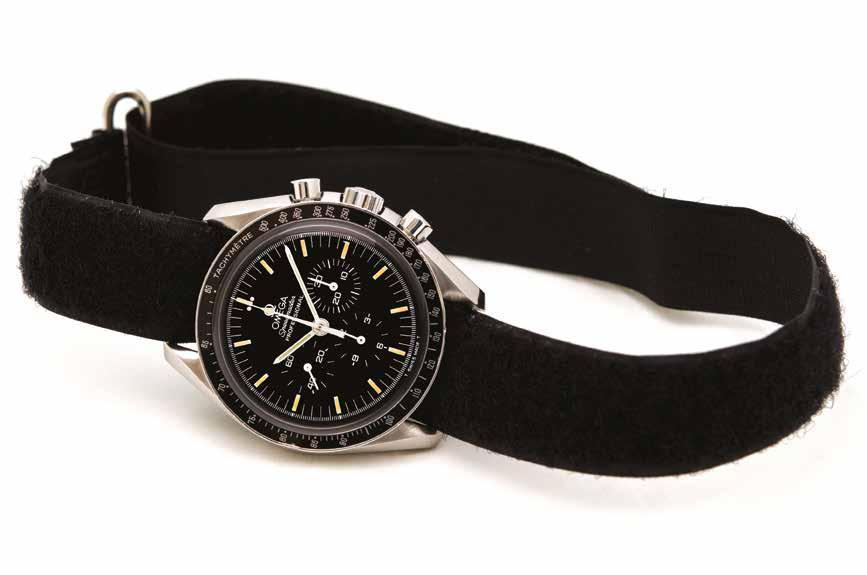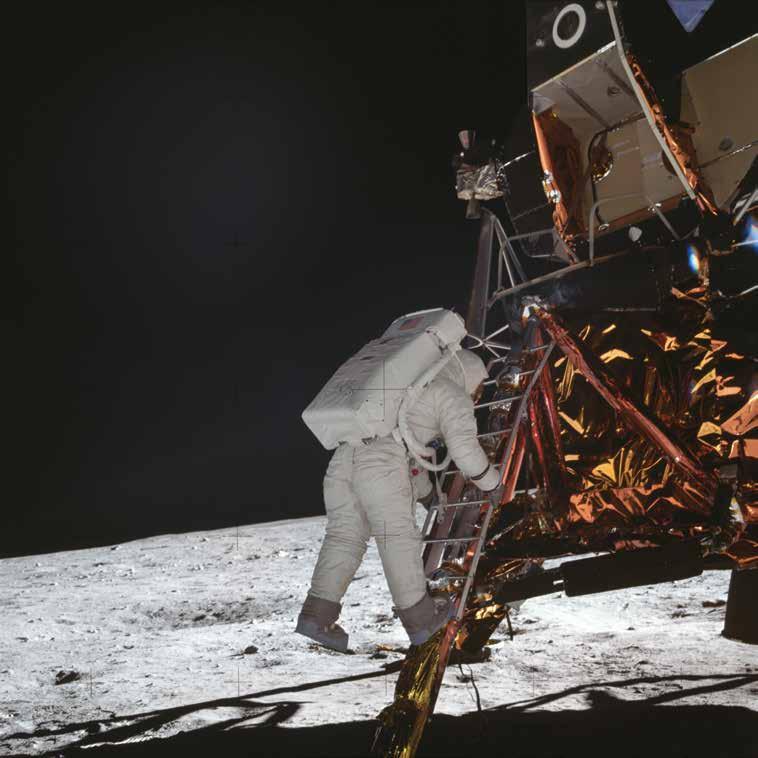MOON WATCH
THE EXTRAORDINARY DESTINY OF THE OMEGA SPEEDMASTER
THE EXTRAORDINARY DESTINY OF THE OMEGA SPEEDMASTER

© 3rd Expanded Edition 2024, Watchprint.com Sàrl, La Croix-sur-Lutry
Watch Stories Collection
All rights reserved. No part of this publication may be reproduced in any manner whatsoever.
The texts in this book are independent of Omega SA. The watch models are illustrated for identification purposes only.
ISBN 978-2-940506-61-3
Publishing Managers: Fabrice Mugnier and Suzanne Wettstein
English Translation: Susan Jacquet, Transcribe
Printing: Graphius, Belgium
See our watch and jewelry-themed publications on our website, www.watchprint.com
“The OMEGA Speedmaster Professional – the Moonwatch – has done things that no other timepiece has done and it’s been worn in places that only a few human beings have been.”
Captain Eugene Cernan The Last Man on the Moon


March 1, 1965. After a long series of extremely stringent and rigorous tests, NASA had just chosen the chronograph watch that would accompany American astronauts on their journey to the Moon. And far beyond, since they still use it today, more than 50 years later, during their spacewalks. This exceptional watch, the Omega Speedmaster, would thus enjoy an extraordinary destiny that has earned it a unique place in the history of the watchmaking industry.
The story had begun several years earlier, in 1957. Since the end of World War II, so-called professional watches had been on the rise. Science, industry, sports and leisure were the themes that watch manufacturers must now address in the design of their models, which could no longer be confined to simple timepieces, elegant but soon outdated.
Omega responded to these new expectations by creating a Railmaster – Seamaster –Speedmaster trilogy. The latter, a chronograph watch, was equipped with an extremely high-performance mechanism developed in the 1940s by its sister company Lemania. It also featured a timeless design and some fundamental innovations such as an external tachymeter bezel to improve readability.
Thanks to its intrinsic qualities, the Speedmaster proved an immediate success. It was well appreciated by a clientele of individuals and professionals who were delighted to have an innovative, solid and reliable measuring instrument on their wrist.
It was precisely with this same intention that one day in 1962, two American customers also decided to buy Omega Speedmaster models. Except these were no ordinary customers. They were famous and had even been considered heroes since their April 1959 integration into the first group of astronauts – The Original Seven – selected by NASA for the Mercury Space Program. Walter “Wally” Schirra and Gordon “Gordo” Cooper were in fact thus completing their equipment for their next flights (Mercury 8 in October 1962 for Schirra and Mercury 9 in May 1963 for Gordon).
They had no idea they had just written the first chapter in an amazing adventure: that of the Speedmaster in the conquest of space.
But this was still only a private initiative. At that time, NASA, which had only been created in 1958, was tasked with a wild challenge set by President John Fitzgerald Kennedy in his speech on May 25, 1961: “I believe that this nation should commit itself to achieving the goal, before this decade is out, of landing a man on the Moon and returning him safely to Earth”.
FIRST CHRONOGRAPH
The first chronographs (then called “chronoscopes”) launched by the Brandt brothers under the Omega brand date back to 1898. These were pocket chronographs, equipped with the 19-ligne CHRO caliber.
A bit of vocabulary...
The terms “timer”, “chronograph” and “chronometer” should not be confused.
A timer does not indicate the time but simply the duration of a phenomenon, displaying (at least) fractions of seconds, seconds, and a total of minutes.
A chronograph is a combination of watch and timer: it is a timepiece equipped with an additional mechanism to measure the duration of an event with a central seconds hand (chronograph hand) and possibly hours and minutes counters.
A chronometer is a high-precision watch capable of displaying the seconds, whose movement has been tested over several days in different positions and at different temperatures by a neutral official body, the Swiss Official Chronometer Testing Institute (COSC).
A chronograph may also be a chronometer.
Opposite page: 18K gold pocket chronograph equipped with the 19-ligne CHRO caliber, dating from 1906 (owned by the Omega Museum).




CHANGE OF SHAPE
On the first Speedmasters (up to reference ST 105.003), the pushers and crowns were not protected against any impacts or snagging.
An evolution in the shape of the caseband was developed in 1963 and first marketed in 1964, on the new reference ST 105.012. Protuberances on the right side thus enabled smoother integration of the pushers and the crown.
The shape of the lugs (the parts holding the strap) of the watch also changed: initially straight on the previous casebands, they adopted a lyre-type shape on the new ones. These structural changes made the watch more robust and therefore more reliable. Paradoxically, however, it was not the ST 105.012 model that was tested by NASA in 1965, but the old ST 105.003 model (see next chapter).
This evolution is fundamental in the history of the Speedmaster, since the models on sale today still have the same shape.
From 1963, the Speedmaster’s caseband changed shape, becoming asymmetrical (opposite page, below) with pushers and crown now integrated and better protected (unlike the previous generations, opposite page, above).
FIRST MANNED APOLLO MISSIONS
Apollo 7 (October 11 - 22, 1968) was the first manned mission of the Apollo program, launched by the Saturn IB space rocket. It was also the first American mission to send a team of three men into space and the first mission to broadcast images for television. Its crew consisted of the three alternate members of the Apollo 1 mission, Walter Schirra (Commander), Donn Eisele (Command Module Pilot), and Walter Cunningham (Lunar Module Pilot).
Apollo 8 (December 21 - 27, 1968) was the program’s second manned mission. Its importance is now overshadowed by the success of Apollo 11, yet it had a worldwide impact at the time because of the many firsts accomplished by its crew (Frank Borman, Commander, Jim Lovell, Command Module Pilot, and William Anders, Lunar Module Pilot):
• first manned spaceflight beyond Earth’s orbit;
• first direct view of the Earth as a whole;
• first launch into orbit around another body (the Moon);
• first direct view of the hidden face of the Moon;
• first view of an Earthrise from the Moon.
Opposite page: December 1968: James Lovell, Commander of the Apollo 8 mission, wears a Speedmaster Professional ST 105.012 on take-off.


this page and next page:

his



2998 LOLLIPOP 1960

REF. CK 2998 Second-generation Speedmaster, with black tachymeter bezel.

APOLLO XI WHITE GOLD

REF. BC 345.0802 First Speedmaster with transparent caseback, in white gold.
APOLLO XI YELLOW GOLD


REF. BA 345.0802 First Speedmaster with transparent caseback, in yellow gold.


DARK SIDE OF THE MOON APOLLO 8 – SATURN V


REF. 310.92.44.50.01.001 Apollo 8 returns in an improved version of the one issued in 2018 featuring a new caliber 3861, a more detailed moon surface, a rubber strap with folding clasp and a fun little detail in the shape of the Saturn V rocket playing the role of seconds hand.
